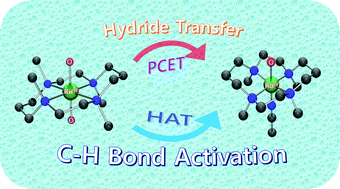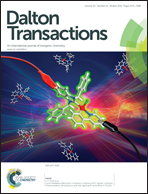Mechanistic insights into the reactions of hydride transfer versus hydrogen atom transfer by a trans-dioxoruthenium(vi) complex†
Abstract
A mononuclear high-valent trans-dioxoruthenium(VI) complex, trans-[RuVI(TMC)(O)2]2+ (TMC = 1,4,8,11-tetramethyl-1,4,8,11-tetraazacyclotetradecane), was synthesized and characterized by various spectroscopic techniques and X-ray crystallography. The reactivity of the trans-[RuVI(TMC)(O)2]2+ complex was investigated in hydride transfer and hydrogen atom transfer reactions. The mechanism of hydride transfer from dihydronicotinamide adenine dinucleotide (NADH) analogues to trans-[RuVI(TMC)(O)2]2+, which proceeds via a proton-coupled electron transfer (PCET), followed by a rapid electron transfer (ET), has been proposed by the observation of a good linear correlation between the log rate constants of trans-[RuVI(TMC)(O)2]2+ and p-chloranil (Cl4Q) and a large kinetic isotope effect (KIE) value of 13(1). In the case of the oxidation of alkyl hydrocarbons by the trans-[RuVI(TMC)(O)2]2+ complex, the second-order rate constants were dependent on the C–H bond dissociation energy (BDE) of the substrates, and a large KIE value of 26(2) was obtained in the oxidation of xanthene and deuterated xanthene-d2 by the trans-[RuVI(TMC)(O)2]2+ complex, indicating that the C–H bond activation of alkyl hydrocarbons proceeds via an H-atom abstraction in the rate-determining step.


 Please wait while we load your content...
Please wait while we load your content...